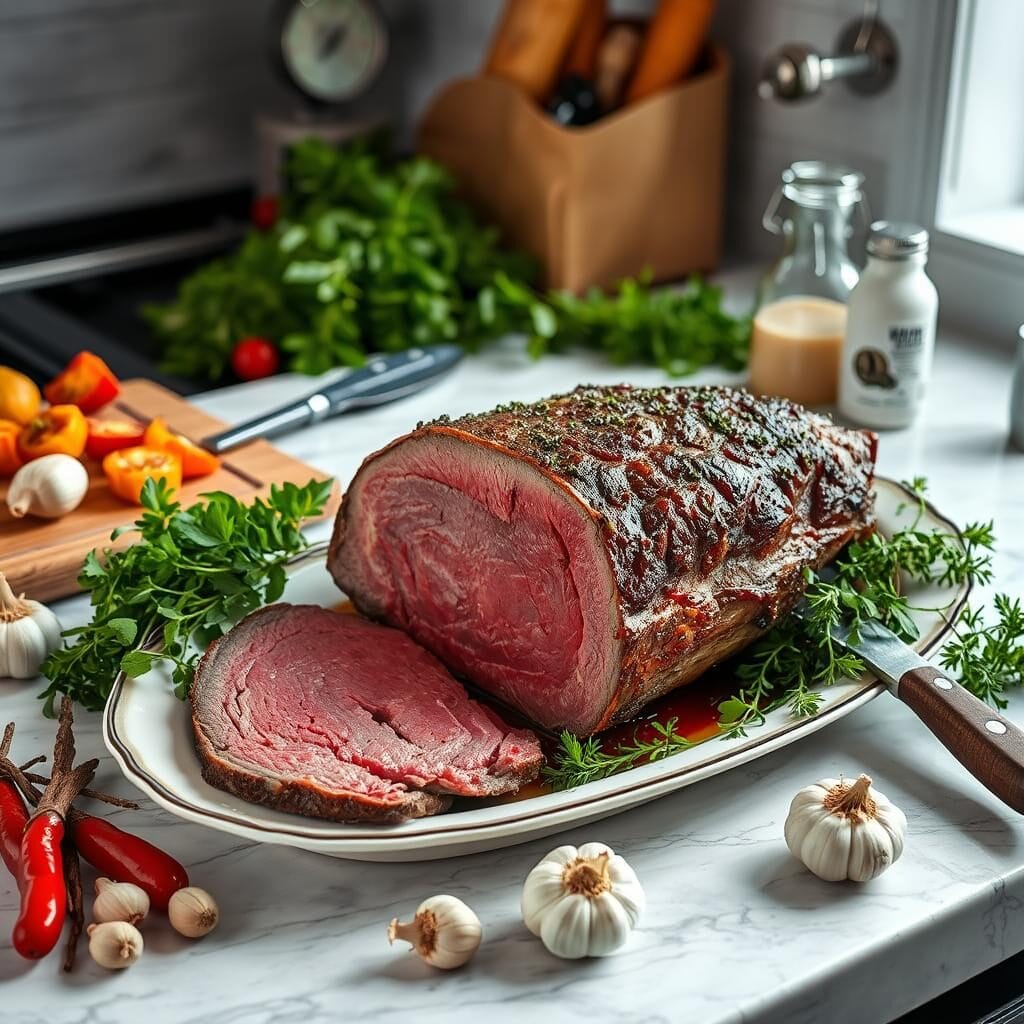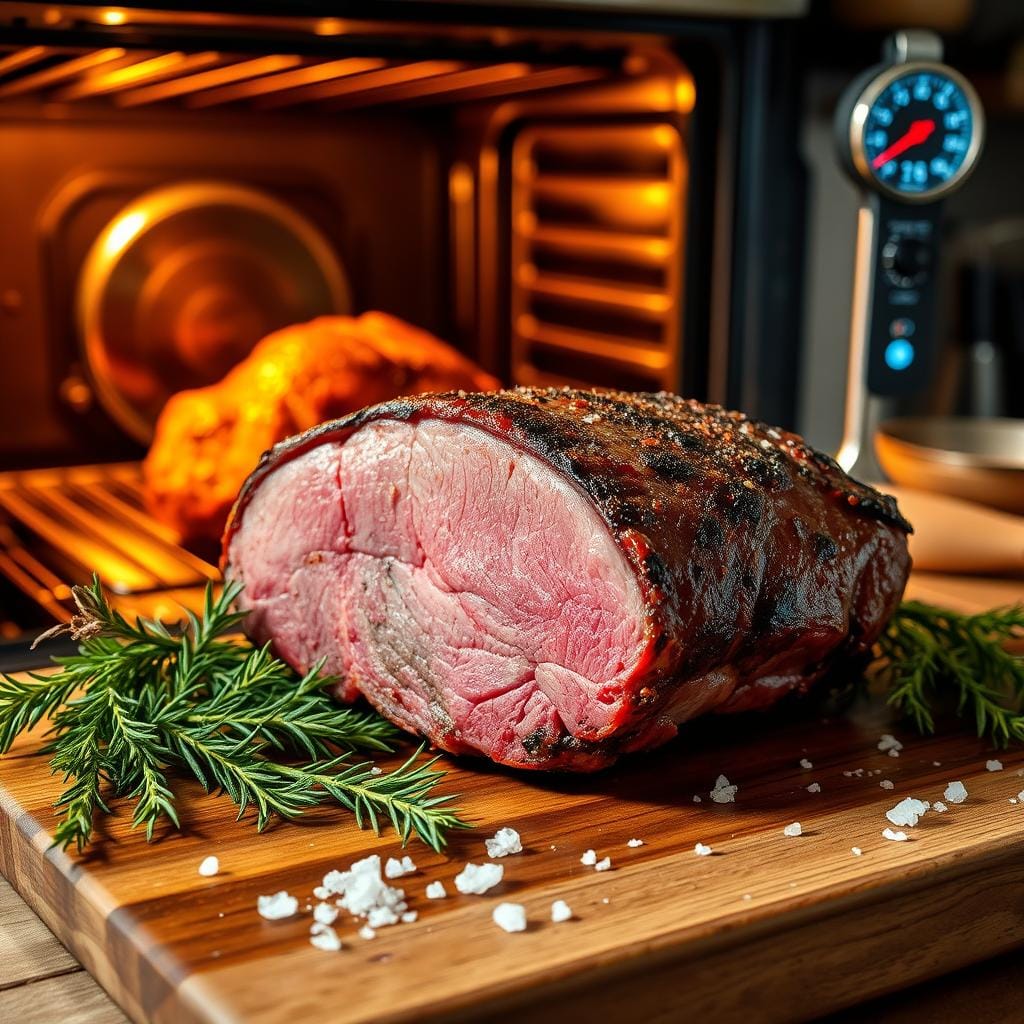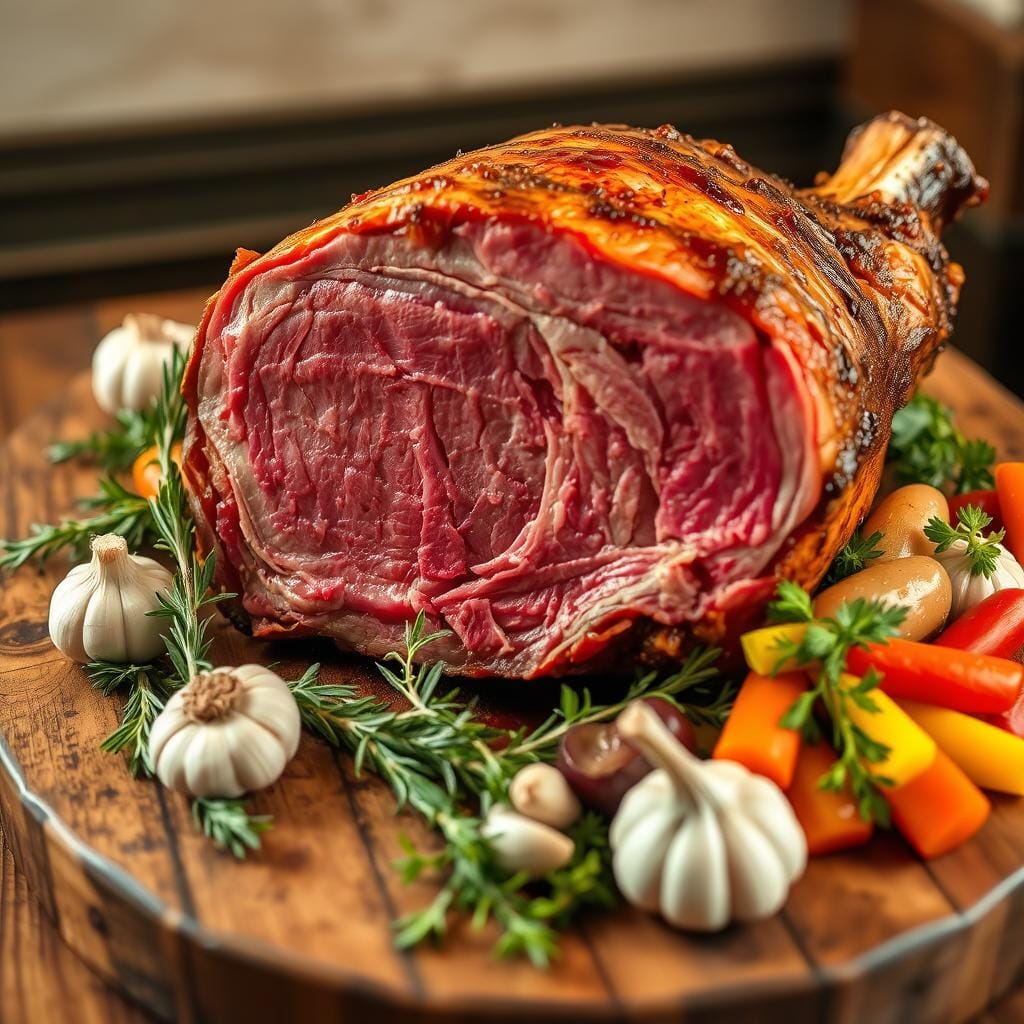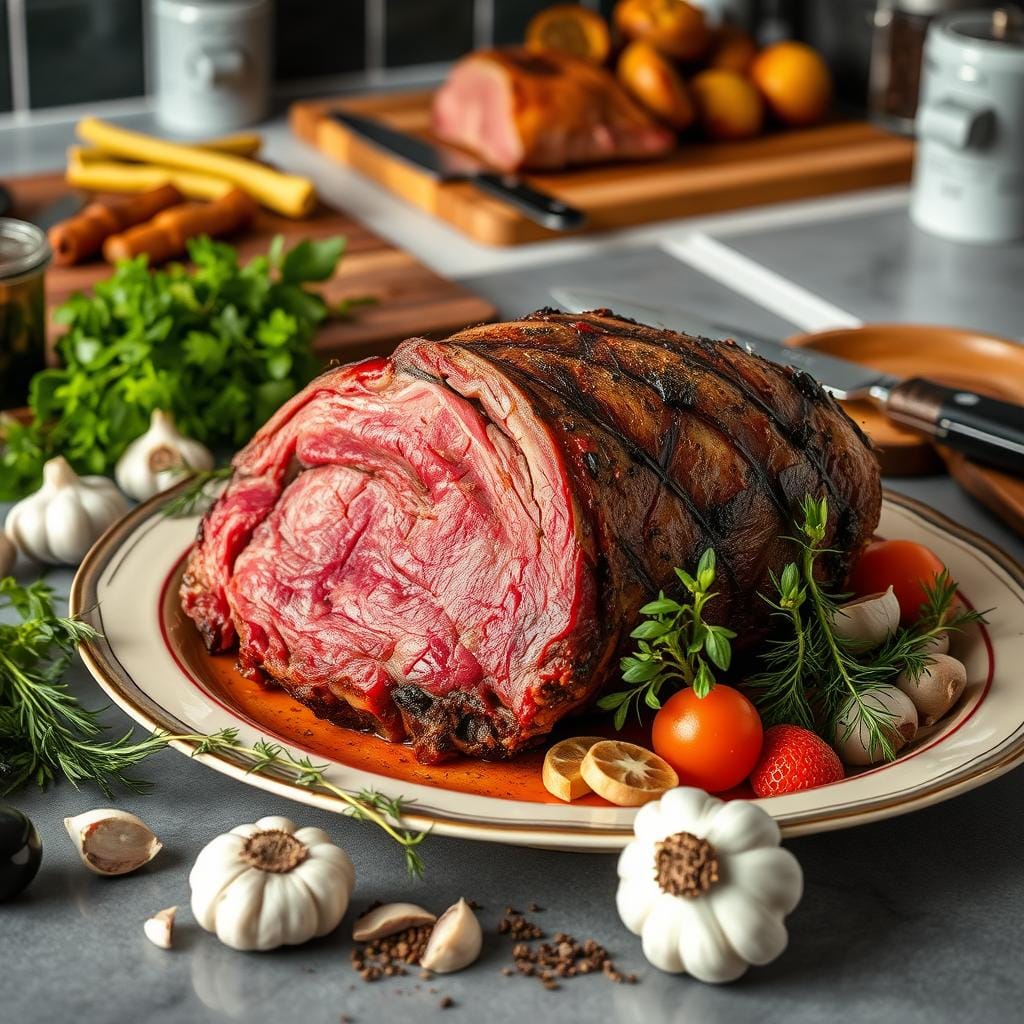What is the secret of cooking a prime rib roast? The aroma of a perfectly cooked prime rib instantly evokes memories of family gatherings and cherished moments. The anticipation of slicing into that juicy, well-marbled beef is enough to excite any food lover and make their mouth water. So, what’s the key to getting it just right every time?
In this guide, we’ll share the techniques and tips to make your prime rib roast a showstopper. It will be the highlight of your next special meal.

Key Takeaways
- Understand the fundamentals of prime rib, including the role of marbling and USDA grade.
- Learn how to select the perfect prime rib cut for your needs and cooking preferences.
- Discover the essential equipment and tools required for flawless prime rib preparation and roasting.
- Master the art of creating the ultimate seasoning blend to enhance the natural flavors of the prime rib.
- Explore the step-by-step preparation and cooking methods, including the reverse sear technique.
What is the Secret of Cooking a Prime Rib Roast?
Cooking a prime rib roast is a journey that can make any meal special. At its core, it’s about understanding the prime rib. Let’s explore the secrets behind this beloved cut of meat.
Understanding Prime Rib Basics
Prime rib, also known as standing rib roast, comes from the cow’s rib area. It’s famous for its marbling, which makes the meat tender and flavorful. This cut is the most expensive and indulgent, perfect for special occasions.
The Role of Marbling and Grade
The quality of the meat is key to a great prime rib roast. The USDA grades beef based on marbling, or intramuscular fat. A higher grade, like “Prime,” means more marbling for a tender and flavorful dish. Knowing about marbling and grade helps choose the best prime rib.
| USDA Grade | Marbling Level | Tenderness | Flavor |
|---|---|---|---|
| Prime | Abundant | Extremely Tender | Exceptional |
| Choice | Moderate | Very Tender | Delicious |
| Select | Modest | Tender | Flavorful |

Knowing the basics of prime rib and its marbling and grade is the first step. This will help you master the art of cooking a what is the secret of cooking a prime rib roast? to perfection. Next, we’ll cover how to choose the right cut, the essential equipment, and the step-by-step preparation methods for a culinary success.
Selecting the Perfect Prime Rib Cut
Choosing the right prime rib cut is key to a delicious prime rib roast recipe. As a prime rib cooking fan, focus on the size, age, and quality signs. This ensures you start with the best ingredients for your dish.
The size of the prime rib roast matters. You can find them in sizes from one rib to seven ribs. Choose based on how many you’re serving and what you like. A good rule is to plan for 1 pound of prime rib per person for enough food.
The age of the prime rib is also important. Look for one aged at least 21 days. This aging makes the meat tender and boosts the flavor. Also, check for marbling, a deep red color, and a firm texture to ensure quality.
| Prime Rib Cut Size | Recommended Servings |
|---|---|
| 1 rib | 2-3 people |
| 2 ribs | 4-6 people |
| 3 ribs | 6-8 people |
| 4 ribs | 8-10 people |
| 5 ribs | 10-12 people |
| 6 ribs | 12-14 people |
| 7 ribs | 14-16 people |
Remember these tips to find the perfect prime rib cut for your next roast. With the right cut, you’re ready for a memorable dining experience.

Essential Equipment for Perfect Prime Rib
To make a delicious prime rib roast, you need more than just great meat. The right tools are key to cooking a perfect prime rib every time. You’ll need temperature monitoring tools and special roasting pans to master prime rib cooking.
Temperature Monitoring Tools
Getting the temperature just right is crucial for a perfect prime rib. A good meat thermometer, like a digital or probe model, is essential. It helps you follow the prime rib temperature guide and cook the roast to your liking.
Roasting Pans and Racks
A sturdy roasting pan with a rack is vital for prime rib cooking tips. Choose a pan with high sides to catch juices and a rack for even air flow. Some pans have V-shaped racks for better even cooking.
Kitchen Tools for Preparation
- Sharp carving knife: For expertly slicing the cooked prime rib
- Basting brush: To apply any marinades, sauces, or pan juices during cooking
- Meat tongs: For easily handling and maneuvering the roast
- Cutting board: A large, sturdy cutting board is essential for carving the prime rib
With these essential tools, you’re ready to make the perfect prime rib roast. From start to finish, you’ll be on the right track.
“The right equipment can make all the difference in ensuring your prime rib turns out perfectly cooked every time.”
Prime Rib Temperature Guide for Different Doneness Levels
Getting the perfect doneness is key to a great prime rib roast. Whether you like it rare, medium-rare, or well-done, knowing the right internal temperatures is crucial. This ensures your prime rib is always a hit.
The prime rib temperature guide below outlines the range of internal temperatures for various doneness levels:
- Rare: 120-125°F (49-52°C)
- Medium-Rare: 130-135°F (54-57°C)
- Medium: 140-145°F (60-63°C)
- Medium-Well: 150-155°F (66-68°C)
- Well-Done: 160°F (71°C) and above
Remember, the prime rib’s temperature will rise a bit after you take it out of the oven. So, remove it a few degrees before your desired doneness. This ensures it’s tender and juicy.
| Doneness Level | Internal Temperature | Appearance |
|---|---|---|
| Rare | 120-125°F (49-52°C) | Cool red center, bright red juices |
| Medium-Rare | 130-135°F (54-57°C) | Warm red center, pinkish-red juices |
| Medium | 140-145°F (60-63°C) | Warm pink center, clear juices |
| Medium-Well | 150-155°F (66-68°C) | Slightly pink center, clear juices |
| Well-Done | 160°F (71°C) and above | Gray-brown throughout, clear juices |
With a reliable meat thermometer and this guide, you’ll get the perfect prime rib every time. It’s sure to please your taste buds.
Creating the Ultimate Prime Rib Seasoning Blend
To take your prime rib roast to the next level, start with the perfect seasoning blend. This blend is key to unlocking the meat’s rich, succulent flavors. Let’s look at the essential components and spice mixes that will make your prime rib roast recipe a true masterpiece.
Dry Rub Components
The heart of a flavorful prime rib seasoning is the dry rub. This mix of spices and herbs is applied to the meat before roasting. It creates a delicious crust. Begin with a blend of:
- Coarse sea salt or kosher salt
- Freshly ground black pepper
- Garlic powder
- Onion powder
- Paprika (smoked or sweet)
Herbs and Spices Selection
To enhance your prime rib seasoning, add fragrant herbs and more spices. Consider these options:
- Dried thyme or rosemary
- Ground cumin
- Cayenne pepper (for a touch of heat)
- Dried oregano or basil
- Fennel seeds (for a subtle licorice flavor)
Combining these dry rub components with aromatic herbs and spices will make a prime rib seasoning blend that will impress your guests.
Step-by-Step Preparation Method
Preparing a perfect prime rib roast is all about paying attention to detail. Follow these step-by-step instructions to make sure your prime rib roast recipe turns out great:
- Trim the prime rib: Remove any excess fat and silver skin from the surface of the meat. Leave a thin layer of fat to help baste the roast during cooking.
- Tie the roast: Secure the roast with kitchen string, tying it at regular intervals. This helps it hold its shape during cooking.
- Season the prime rib: Apply a flavorful dry rub or seasoning blend all over the surface of the meat. Prime rib cooking tips suggest using herbs, spices, and salt for a delicious crust.
- Let it rest: Allow the seasoned prime rib to sit at room temperature for 30 to 60 minutes before cooking. This ensures even temperature and consistent doneness.
By following these simple steps, you’ll have a beautifully prepared prime rib roast. It’s ready for the next stage of cooking. Remember, paying attention to detail is crucial for mastering the prime rib roast recipe.
Perfect Prime Rib Roasting Techniques
Cooking a delicious prime rib roast is all about the right roasting technique. You can choose between the reverse sear and the traditional roasting method. The secret to a tender prime rib roast is in the details.
Reverse Sear Method
The reverse sear starts with slow roasting at 225°F (107°C). This method lets the meat cook evenly. After reaching the right prime rib roasting time, sear it at high heat for a crispy outside.
Traditional Roasting Approach
The traditional method starts with a high temperature, around 450°F (232°C), for a flavorful crust. Then, lower the temperature to 325°F (163°C) to cook the inside. This method keeps the meat juicy and tender.
Resting Period Importance
The resting period is key, no matter the method. Let the roast rest for 15-30 minutes after removing it from the oven. This step ensures the meat stays moist and flavorful.
| Roasting Technique | Initial Temperature | Final Temperature | Resting Time |
|---|---|---|---|
| Reverse Sear | 225°F (107°C) | Sear at high heat | 15-30 minutes |
| Traditional Roasting | 450°F (232°C) | 325°F (163°C) | 15-30 minutes |
Learning about these roasting techniques and the resting period can help you make a prime rib roast that’s juicy and full of flavor.
Common Prime Rib Cooking Mistakes to Avoid
Cooking the perfect prime rib roast needs precision and care. Even experienced chefs can make mistakes that spoil the dish. We’ll look at common errors and offer tips to steer clear of them.
Overlooking Temperature Control
Keeping the right internal temperature is key for a juicy prime rib. Overcooking makes it dry and tough, while undercooking is unsafe. Use a prime rib temperature guide and a good meat thermometer to get it just right.
Insufficient Seasoning
A seasoned prime rib brings out its rich flavor. Skipping seasoning makes it taste bland. Try different prime rib cooking tips, like a dry rub or herb basting, for a tasty crust.
Incorrect Cooking Times
Finding the right cooking time for prime rib is tricky. Cooking too fast makes it underdone, while too long makes it tough. Stick to a prime rib temperature guide and be patient for the best results.
By avoiding these mistakes, you’ll make a prime rib that wows everyone.
“The secret to a perfect prime rib is patience and precision. Take the time to get the temperature right, and you’ll be rewarded with a juicy, flavorful roast every time.”
Expert Carving Techniques for Prime Rib
Learning to carve a prime rib roast is key to a great meal. The right techniques make each slice juicy and full of flavor. This premium beef cut deserves nothing less.
Proper Knife Selection
Choosing the right knife is crucial for easy carving. A sharp, high-quality carving knife with a long, thin blade is best. It slices the prime rib smoothly and evenly.
Step-by-Step Carving Guide
- Let the roast rest for 15-20 minutes before carving. This step makes it juicy and flavorful.
- Place the roast with the bone down on a cutting board. This makes carving easier.
- Carve the meat against the grain in thin slices. Start from the narrow end and move to the thicker end.
- Keep the slicing angle consistent for even slices. Aim for 1/4 to 1/2 inch thick.
- Arrange the slices on a platter in an overlapping pattern. This shows off the roast’s beauty.
By using these prime rib carving techniques, you can make a stunning dish. Add some prime rib cooking tips, and you’re ready for a memorable meal.
Elegant Side Dishes to Complement Your Prime Rib
When you serve a delicious prime rib roast, picking the right side dishes is key. They should match the rich flavor of the meat. There are many side dishes that can make your prime rib dish even better.
Roasted garlic mashed potatoes are a timeless favorite. They pair well with the prime rib because of their creamy texture and garlic taste. Another classic is roasted asparagus, which adds a fresh touch to the meal.
For a touch of elegance, try sautéed mushrooms or caramelized onions. These side dishes not only taste great but also look good with the prime rib.
Looking to try something new? Grilled broccolini or roasted Brussels sprouts are great options. They add a nice crunch and a bit of bitterness to balance the prime rib’s richness.
| Side Dish | Flavor Profile | Preparation Tip |
|---|---|---|
| Roasted Garlic Mashed Potatoes | Creamy, Garlicky | Roast garlic cloves until softened, then mash into the potatoes. |
| Roasted Asparagus | Fresh, Crisp | Toss asparagus with olive oil, salt, and pepper, then roast until tender-crisp. |
| Sautéed Mushrooms | Earthy, Savory | Sauté mushrooms in butter or olive oil with garlic and herbs. |
| Caramelized Onions | Sweet, Tangy | Slowly cook onions over low heat until they develop a deep, caramelized flavor. |
| Grilled Broccolini | Smoky, Crisp | Toss broccolini with oil, salt, and pepper, then grill until charred and tender. |
| Roasted Brussels Sprouts | Nutty, Crispy | Roast Brussels sprouts with olive oil, salt, and pepper until golden brown. |
Pairing your prime rib roast with these elegant side dishes will make your meal unforgettable. It will highlight the best of both the main course and the sides.
Wine Pairing Suggestions for Prime Rib
Choosing the right wine for your prime rib is key. The rich flavors of prime rib need wines that match its bold taste. Whether you like red or white, think about a few things when picking the best wine.
Red Wine Pairings
Full-bodied red wines pair well with prime rib. Cabernet Sauvignon is a top choice, with its strong fruit flavors and tannins that match the meat’s taste. Malbec and Syrah are also great, adding spice and dark berry notes that enhance the prime rib.
White Wine Pairings
White wines can also pair well with prime rib. A rich, oaked Chardonnay offers a creamy contrast to the beef. A crisp Sauvignon Blanc can cut through the richness and refresh your taste buds.
“The key to a perfect prime rib wine pairing is finding a wine that can stand up to the boldness of the meat without overpowering it. The right wine will elevate the entire dining experience.”
Choose a wine that you and your guests will love. Try different wines to find the best match for your prime rib.
| Wine Varietal | Flavor Profile | Why It Works |
|---|---|---|
| Cabernet Sauvignon | Full-bodied, with notes of dark fruit, oak, and tannins | The bold flavors and structure of Cabernet Sauvignon can stand up to the richness of prime rib. |
| Malbec | Robust, with ripe black fruit, spice, and soft tannins | The fruit-forward nature of Malbec complements the savory qualities of the prime rib. |
| Chardonnay | Rich, creamy, and often oak-aged | The buttery, smooth texture of an oaked Chardonnay can balance the richness of the prime rib. |
| Sauvignon Blanc | Crisp, with citrus and herbaceous notes | The bright acidity of Sauvignon Blanc can cut through the fat and refresh the palate. |
Conclusion
In this guide, you’ve learned the secrets to cooking a perfect prime rib roast. You now know how to pick the right cut, set up your kitchen, and cook it just right. This knowledge will help you make a prime rib that will wow your guests.
Enjoying your prime rib’s rich flavors and tender texture is just the start. Don’t throw away leftovers. Turn them into tasty dishes like sandwiches, hash, or stew. This way, you can enjoy the full flavor of your prime rib in many different ways.
With what you’ve learned, you’re ready to become a prime rib expert. You can now make amazing prime ribs in your own kitchen. Enjoy the process and make your meals even more special. Bon appétit!
FAQ
What is the secret of cooking a prime rib roast?
Cooking a prime rib roast to perfection involves a few key steps. First, understand the basics of prime rib. Then, choose the right cut and use the right equipment. Finally, master the cooking techniques.
From picking the perfect prime rib to seasoning it right, there are several important steps. These steps help create a delicious prime rib experience.
What are the essential tips for cooking a prime rib roast?
To cook a prime rib roast well, follow these tips. First, know how marbling and USDA grading affect flavor and texture. Then, pick the right size and quality of prime rib.
Use the right equipment, like a meat thermometer and a sturdy roasting pan. Aim for the ideal internal temperature for your desired doneness. Create a flavorful seasoning blend to enhance the meat’s taste.
Follow the proper preparation and roasting techniques, like the reverse sear method. Let the roast rest for optimal juiciness and tenderness.
What is the best way to season a prime rib roast?
To season a prime rib roast, start with a dry rub. Mix coarse salt, freshly ground black pepper, and herbs like garlic, thyme, or rosemary. Coat the entire roast evenly, rubbing the seasoning into the meat for maximum flavor.
How long should I roast a prime rib?
Roasting time for a prime rib roast varies by size and desired doneness. For a 4-6 lb prime rib, roast at 500°F for 15 minutes. Then, reduce the temperature to 250°F and roast for 2-3 hours, until it reaches your preferred internal temperature.
For a 6-8 lb prime rib, roast at 500°F for 20 minutes. Then, reduce the temperature to 250°F and roast for 3-4 hours, until it reaches your desired doneness. Always use a reliable meat thermometer to ensure the perfect internal temperature.
What is the best way to carve a prime rib roast?
To carve a prime rib roast, start by selecting a sharp, long slicing knife. Place the roast with the bones facing you. Slice against the grain of the meat, making even, thin cuts.
Let the roast rest for at least 15-20 minutes before carving. This allows the juices to redistribute. Serve the sliced prime rib immediately for the ultimate dining experience.
What are some tasty side dishes that pair well with prime rib?
Prime rib goes well with many side dishes. Some great options include creamy mashed potatoes and roasted garlic and herb-infused potatoes. Sautéed mushrooms and onions, freshly baked Yorkshire puddings, and buttery green beans or asparagus are also excellent choices.
A crisp salad with a tangy vinaigrette pairs well too.
What type of wine pairs best with prime rib?
Prime rib pairs well with full-bodied red wines. Cabernet Sauvignon, with its robust tannins and bold fruit flavors, is a great choice. Merlot’s smooth texture and jammy fruit notes also complement the prime rib’s savory character.
Bordeaux Blends, with their blend of Cabernet Sauvignon, Merlot, and other varietals, beautifully accent the prime rib’s flavors. For a lighter pairing, consider a full-bodied Pinot Noir or a rich Syrah.


